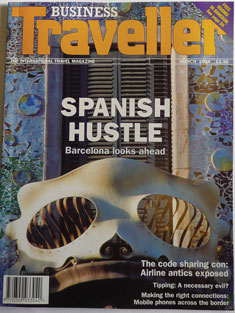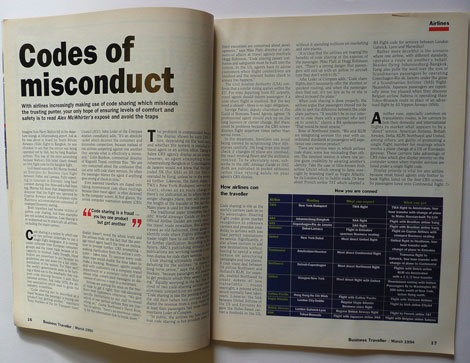Alex McWhirter looks through the Business Traveller archive. This month: This month, a March 1994 article on codeshare flights
 Two decades ago, booking a codeshare flight was a lottery. Unless passengers did their homework or patronised a good travel agent, chances are they would be unaware of which airline they were flying or which routing they would be taking.
Two decades ago, booking a codeshare flight was a lottery. Unless passengers did their homework or patronised a good travel agent, chances are they would be unaware of which airline they were flying or which routing they would be taking.
Codesharing, a practice where two or more carriers undertake to use a single flight designator, offered airlines huge cost benefits but at the passengers’ expense. Simply put, it meant that an airline could hive off a route to another carrier or carriers but still collect a share of the revenue. There was no legal obligation for that airline to show prominently the operating company or the routing.
Said Tony Hockley of the then Air Transport Users Council (AUC) in 1994: “Codesharing can be described as a fraud because the passenger is buying one product but getting another.”
In 1994, most travellers booked through a third party and the airlines traded on the fact that the lazy agents would have neither the time nor the inclination to unravel the operating carrier or the itinerary.
Some of the more blatant examples we wrote about in 1994 were:
- SAS marketed a Copenhagen-Rio de Janeiro service when in fact the flight was operated by Brazil’s Varig.
- BA sold London Gatwick-Lyon flights operated by French airline TAT (like Varig, no longer in operation).
- Emirates’ Dubai-Larnaca service was operated by Cyprus Airways, whose business class was not of the same standard.
- United’s Glasgow-New York JFK service, ostensibly marketed as a through flight, involved flying Glasgow-Washington DC (320km south) before changing planes and heading north.
- Trans World Airlines (TWA) marketed a through service from New York JFK to Budapest. What passengers weren’t told was that this involved a TWA flight to Amsterdam, a four-hour transit, then a plane change to a Soviet-era TU-134 operated by Hungarian airline Malev (like TWA, now defunct).

Consumer law at that time was weak and displays in the early global distribution systems (GDSs) were hopelessly biased. The airlines got away with such mis-selling for a good few years until consumer pressure (Business Traveller was inundated with reader complaints in the 1990s) forced governments to act. The regulatory bodies then compelled the airlines and the GDS firms to provide the neutral, detailed displays that we see today.
Still, although changes were made in the West, those travelling in other areas of the world have had to wait longer.
Barely ten years ago, I handled an Ask Alex complaint about a codeshare confusion for a flight linking Bangkok with a city in mainland China. But that issue was eventually resolved, and it would be much harder today for anyone to be fooled by a codeshare.








